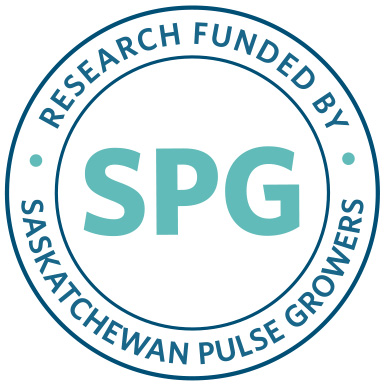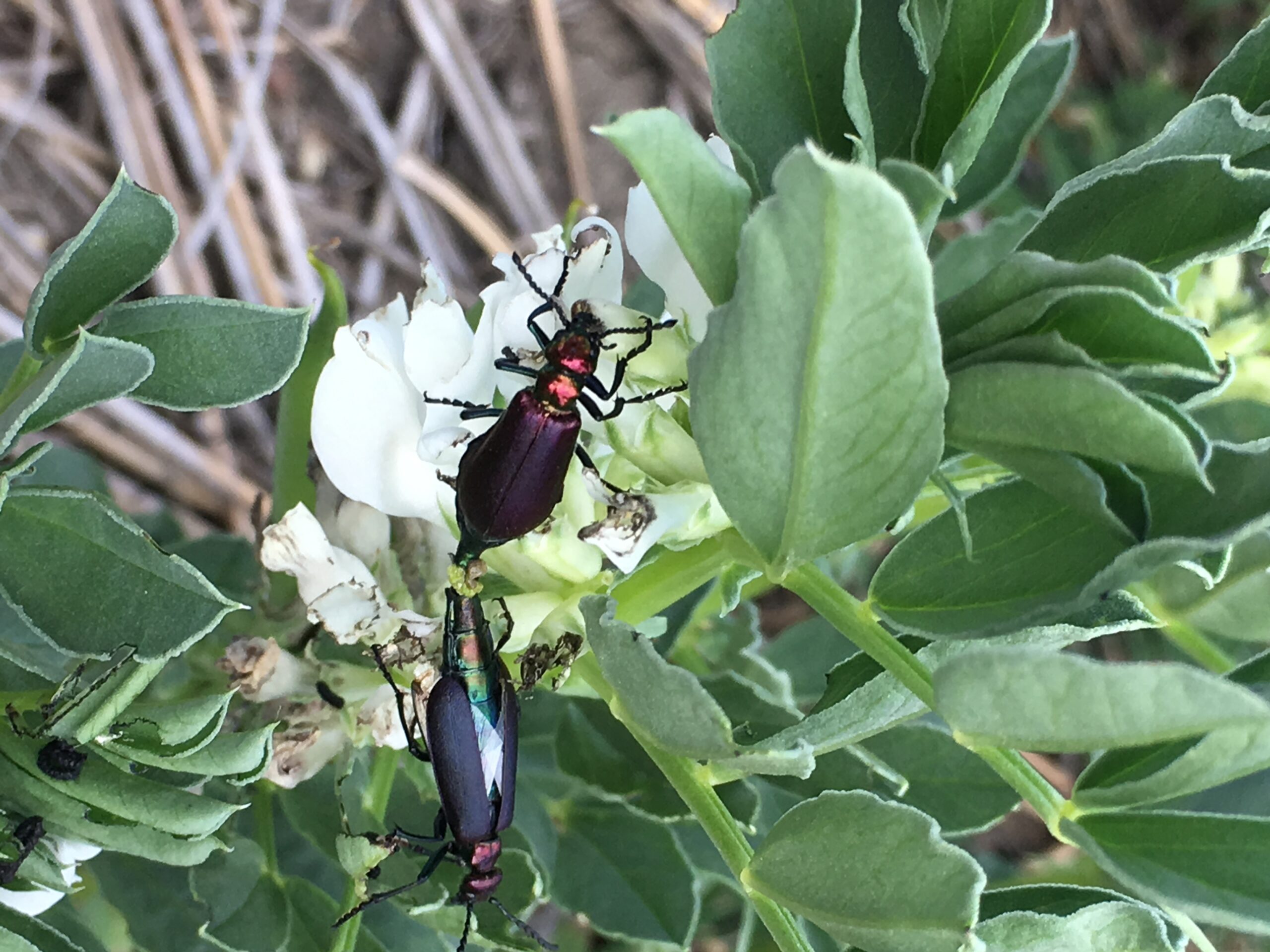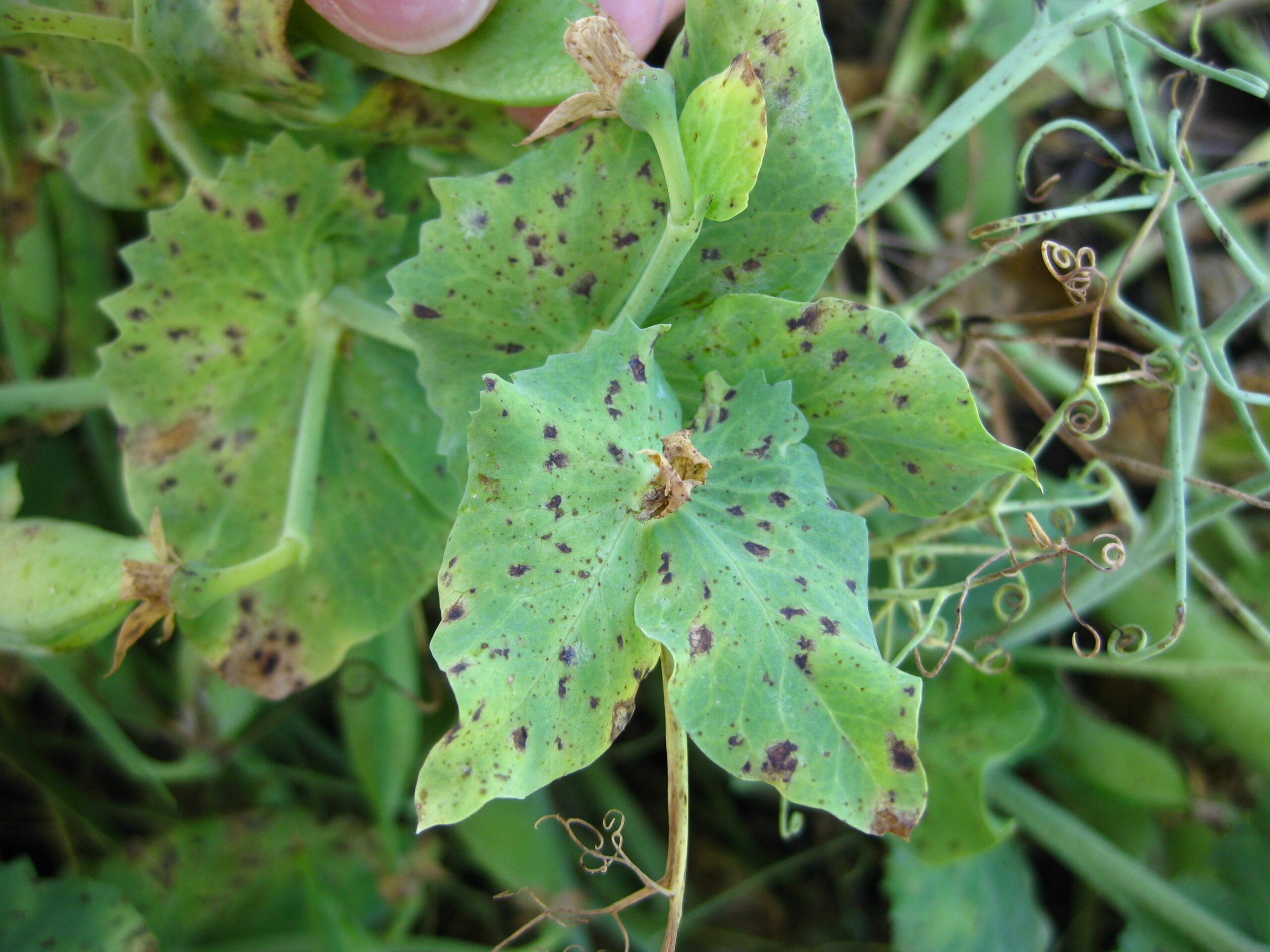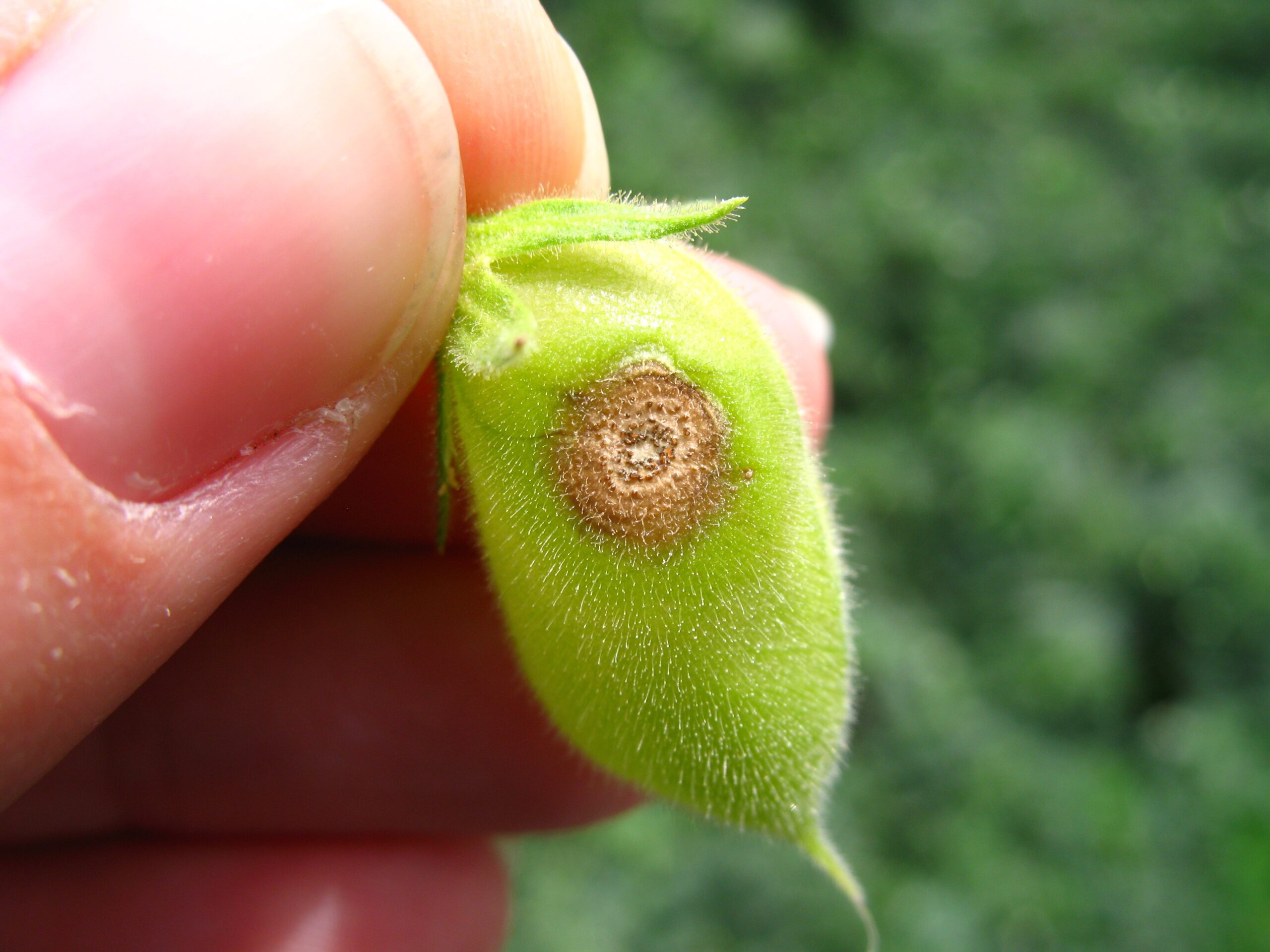By Jennifer Bogdan, PAg., CCA
The two biggest insect challenges in Saskatchewan pulse crops are the pea leaf weevil and the pea aphid. Since its arrival in Saskatchewan in 2007, the pea leaf weevil has remained a challenge to manage in pea and faba bean crops. The pea leaf weevil invades fields over a period of several weeks in the spring, each female can lay over a thousand eggs, and the most damaging stage (larvae) are concealed under the soil surface inside root nodules. Until recently, much of the Western Canadian research on pea leaf weevil had been conducted in Alberta and information was lacking on the overwintering biology of this insect in Saskatchewan. The purpose of this research project was to fill in some of the research gaps related to pea leaf weevil overwintering biology and to determine if the insecticide management practices used in Alberta would also be effective in Saskatchewan.
Pea aphids may overwinter in Saskatchewan in low numbers, but outbreaks can occur in pulse crops on years when strong winds blow them northward from the United States. After their arrival, increases in their natural enemy populations could have a major impact on pea aphid mortality, yet this impact has never been measured in pulse crops. The final objective of this research project was to gather baseline data on pea aphids and their natural enemies to be used in developing a dynamic action threshold for pea aphids in pulse crops.
Overwintering Biology of Pea Leaf Weevil in Saskatchewan
Peak emergence of overwintered adult pea leaf weevil occurred in May, particularly the third and fourth weeks, based on pitfall trap and emergence cage data. Since pea leaf weevil flight occurs at 12.5 °C, the rising average daily temperatures in May contribute to the increased flight activity. Results also showed that baiting pitfall traps with a synthetic aggregation pheromone that attracts both male and female adults was more effective in catching pea leaf weevils than using unbaited pitfall traps, similar to previous research conducted in Alberta.
Pea leaf weevil adults were found to have overwintered near their secondary host plants (ex. alfalfa and sweetclover) along field margins. In a pilot study, the majority of adult pea leaf weevils overwintered at depths of at least 4 centimetres (cm) in the soil.
Exposure to cold temperatures over the winter could impact the survival of pea leaf weevil adults. Using thermal gradient plates, where the temperature of each small growth chamber (cell) can be altered independently of the other cells, researchers tested the survivability of new generation adult weevils under a range of average daily temperatures (from a low of -10°C to a high of 5°C) for periods of 30, 60, 90, 120, and 150 days.
All weevils exposed to temperatures of -7°C and -10°C died within 30 days. At -5°C, the mortality rate in the 30 and 60-day periods was consistently greater than 50%. It should be noted that this experiment was conducted by placing petri dishes of weevils in each thermal gradient cell. Under field conditions, it is unlikely that weevils would experience such prolonged periods of cold temperatures and subsequent high mortality because in the field, their overwintering sites are insulated by soil, crop residues, and snow.
At average daily temperatures of 0°C and 5°C, weevils had a much higher chance of survival (approximately a 60% and 40% chance of survival at 0°C and 5°C, respectively, in one year of the lab study). Interestingly, more weevils were still alive after 150 days when exposed to mean daily temperatures of 0°C compared to 5°C. Weevils were more actively walking around at 5°C, and they likely exhausted their fat stores sooner and starved to death since no food was provided. The researchers concluded that overwintering mortality of pea leaf weevil is influenced by temperature, duration of exposure to extremely cold temperatures, and food availability at warmer temperatures (ex. early spring).
Based on some differences in results between years of the study, one additional factor that the researchers hypothesize may impact overwintering survivability of pea leaf weevil is behaviour exhibited in preparation for overwintering. Future studies should investigate the role of environmental cues that could influence weevil behaviour while pre-conditioning themselves for diapause or fat storage accumulation for winter.
Insecticide Management Options for Pea Leaf Weevil
Small plot trials of field pea comparing the efficacy of a systemic insecticide seed treatment (thiamethoxam, Cruiser®) to foliar insecticide applications (lambda-cyhalothrin, Matador®) on pea leaf weevil were conducted in Swift Current from 2017 to 2019. Due to very low weevil populations in both 2018 and 2019, only the 2017 results could be analyzed.
The control plots and the foliar insecticide-only plots had significantly higher foliar damage and clam-leaf feeding at the three-node stage, as well as higher foliar damage at the five-node stage compared to the thiamethoxam plots. When assessed at the start of flowering, larval damage to the root nodules was also significantly greater in the control and foliar insecticide-only plots compared to any of the thiamethoxam plots (Figure 1).

(p>0.05).
Source: Vankosky, et al., 2020.

Source: Vankosky, et al., 2020.
In addition, more larvae per plant were found in the control and foliar insecticide-only plots (approximately 4 and 3 larvae per plant, respectively). Yield results showed that foliar insecticide applications used in attempt to control pea leaf weevil provided little to no value, a conclusion that has been reached in other recent research as well as in applied field experience (Figure 2).
In 2018 and 2019, the researchers participated in the Plot2Field project led by Alberta Pulse Growers Commission to conduct field scale trials to evaluate the efficacy of systemic insecticides (thiamethoxam) in commercial pea fields across Alberta. In 2018, all sites except one at Claresholm had very low pea leaf weevil populations. While the Claresholm site experienced significantly higher foliar and root nodule damage in the control versus the thiamethoxam treatments, the yield ended up being slightly higher in the control. In 2019, more sites had foliar and root nodule feeding damage, but the effect of thiamethoxam was inconsistent, with only one out of 10 sites having a significantly higher yield increase over the control.
Natural Enemies of Pea Aphids

mummy typical of parasitism by Praon spp. Mummies and aphids were observed on faba bean plants at the Agriculture and Agri-Food Canada Saskatoon Research Farm in 2017.
Source: Dr. Tyler Wist, AAFC Saskatoon
Field peas, lentils, faba beans, and alfalfa crops in central and northeast Saskatchewan were sampled using sweep nets from 2017 to 2019. High pea aphid densities were observed in 2017 and 2019, while very low populations were found in 2018. The dramatic population differences observed year-to-year indicate that pea aphids do not overwinter in the Prairie Provinces, or that only very few individuals survive the winter. Pea aphids remain a migratory pest in the Prairie Provinces.
With the high aphid populations in 2017 and 2019, a number of predator and parasitoids were found in pea aphid host crops. The most common predator found was the seven-spotted lady beetle. The 13-spotted lady beetle was periodically observed. The lady beetles appeared in the host crops shortly after the arrival of pea aphids. Other predators collected were green lacewings, adult and larval syrphid (hover) flies, minute pirate bugs, damsel bugs, two- spotted soft-winged flower beetles, and some spiders.
Two main parasitoids were found attacking pea aphids. Parasitoid mummies (parasitoid pupae protected inside the dead aphid bodies) were detected on faba bean plants later in the season. Aphidius spp. (Hymenoptera: Braconidae) produce brown mummies while Praon spp. (Hymenoptera: Aphidiidae) are characterized by white mummies (Figure 3).
Hyperparasitism (parasitism of parasitoids) was observed in every year when parasitoids were attacking pea aphids. Parasitism and hyperparasitism rates varied across sites, crops, and years.
Key Findings
- Pea leaf weevils overwinter near their secondary host plants, such as alfalfa and sweet clover, near field margins, at depths of approximately 4 cm. Peak pea leaf weevil migration into pea and faba bean fields typically occurs the last two weeks of May when it is warm enough to fly.
- Overwintering survival of pea leaf weevils is determined by temperature, prolonged exposure to extremely cold temperatures, and availa- bility of food at warmer temperatures in the early spring. The amount of insulation provided by soil, crop residue and snow cover will influ- ence the temperature experienced by overwintering weevils.
- Insecticide seed treatments are likely not warranted when pea leaf weevil population densities are low and may perform inconsistently under moderate populations. However, since there are currently no tools available to predict pea leaf weevil populations, growers are advised to make management decisions based on historical weevil distribution in the local area and may be inclined to use an insecticide seed treatment in case it is needed.
- The use of foliar insecticides continues to be an ineffective means of managing pea leaf weevil. They are not recommended due to the difficulty in timing the application as well as the destruction of beneficial insects present during application.
Acknowledgements
Research was funded by Saskatchewan Pulse Growers and Saskatchewan Ministry of Agriculture Development Fund. Work conducted to test the efficacy of systemic insecticides against pea leaf weevil was provided by Alberta Pulse Growers Commission and collaboration in their Plot2Field program.
Vankosky, M., Olfert, O., Mori, B., Wist, T., Poppy, L., Cárcamo, H. 2020. Knowledge, tools, and practices to manage insects of pulse crops in Saskatchewan. ADF Project No. 20160215.

Knowledge, tools and practices to manage insect pests of pulse crops in Saskatchewan
Dr. Meghan Vankosky Agriculture and Agri-Food Canada



